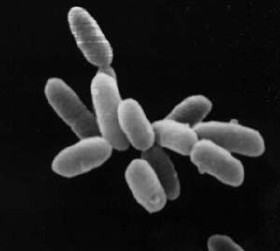Related Research Articles
The Aquificae phylum is a diverse collection of bacteria that live in harsh environmental settings. The name 'Aquificae' was given to this phylum based on an early genus identified within this group, Aquifex, which is able to produce water by oxidizing hydrogen. They have been found in springs, pools, and oceans. They are autotrophs, and are the primary carbon fixers in their environments. These bacteria are Gram-negative, non-spore-forming rods. They are true bacteria as opposed to the other inhabitants of extreme environments, the Archaea.

Streptomyces is the largest genus of Actinobacteria and the type genus of the family Streptomycetaceae. Over 500 species of Streptomyces bacteria have been described. As with the other Actinobacteria, streptomycetes are gram-positive, and have genomes with high GC content. Found predominantly in soil and decaying vegetation, most streptomycetes produce spores, and are noted for their distinct "earthy" odor that results from production of a volatile metabolite, geosmin.

Halomonadaceae is a family of halophilic Proteobacteria.
The Thermotogae are a phylum of the domain Bacteria. The phylum Thermotogae is composed of Gram-negative staining, anaerobic, and mostly thermophilic and hyperthermophilic bacteria.
Sulfur-reducing bacteria are microorganisms able to reduce elemental sulfur (S0) to hydrogen sulfide (H2S). These microbes use inorganic sulfur compounds as electron acceptors to sustain several activities such as respiration, conserving energy and growth, in absence of oxygen. The final product or these processes, sulfide, has a considerable influence on the chemistry of the environment and, in addition, is used as electron donor for a large variety of microbial metabolisms. Several types of bacteria and many non-methanogenic archaea can reduce sulfur. Microbial sulfur reduction was already shown in early studies, which highlighted the first proof of S0 reduction in a vibrioid bacterium from mud, with sulfur as electron acceptor and H2 as electron donor. The first pure cultured species of sulfur-reducing bacteria, Desulfuromonas acetoxidans, was discovered in 1976 and described by Pfennig Norbert and Biebel Hanno as an anaerobic sulfur-reducing and acetate-oxidizing bacterium, not able to reduce sulfate. Only few taxa are true sulfur-reducing bacteria, using sulfur reduction as the only or main catabolic reaction. Normally, they couple this reaction with the oxidation of acetate, succinate or other organic compounds. In general, sulfate-reducing bacteria are able to use both sulfate and elemental sulfur as electron acceptors. Thanks to its abundancy and thermodynamic stability, sulfate is the most studied electron acceptor for anaerobic respiration that involves sulfur compounds. Elemental sulfur, however, is very abundant and important, especially in deep-sea hydrothermal vents, hot springs and other extreme environments, making its isolation more difficult. Some bacteria – such as Proteus, Campylobacter, Pseudomonas and Salmonella – have the ability to reduce sulfur, but can also use oxygen and other terminal electron acceptors.

Haloarchaea are a class of the Euryarchaeota, found in water saturated or nearly saturated with salt. Halobacteria are now recognized as archaea, rather than bacteria and are one of the largest groups. The name 'halobacteria' was assigned to this group of organisms before the existence of the domain Archaea was realized, and while valid according to taxonomic rules, should be updated. Halophilic archaea are generally referred to as haloarchaea to distinguish them from halophilic bacteria.
The Chloroflexi or Chlorobacteria are a phylum of bacteria containing isolates with a diversity of phenotypes, including members that are aerobic thermophiles, which use oxygen and grow well in high temperatures; anoxygenic phototrophs, which use light for photosynthesis ; and anaerobic halorespirers, which uses halogenated organics as electron acceptors.
Actinopolyspora is a genus in the phylum Actinobacteria (Bacteria).
Coprothermobacter proteolyticus, formerly Thermobacteroides proteolyticus, is a thermophilic, non-spore-forming bacteria.
Streptomonospora alba is a halophilic species of bacteria. YIM 90003(T) is the type strain. It is closest to Streptomonospora salina. Its genome sequence was reported in 2015.
Halobacillus karajensis is a species of bacteria. It is halophilic, Gram-positive, spore-forming, strictly aerobic and rod-shaped. Its type strain is MA-2T.
Psychrobacter jeotgali is a species of bacteria named after jeotgal, a traditional Korean fermented seafood, where it was first isolated. It is a Gram-negative, non-motile, non-spore-forming, and moderately halophilic coccus. The type strain is YKJ-103T.
Tetragenococcus muriaticus is a species of moderately halophilic lactic acid, histamine-producing bacteria. X-1 is the type strain of this species.
Microbulbifer salipaludis is a moderate halophilic bacteria. It is Gram-negative, non-motile, non-spore-forming and rod-shaped. The type strain of the species is strain SM-1T.
Filobacillus is a genus of bacteria within the phylum Firmicutes. It contains the type and only species, Filobacillus milensis, though other species and strains have been isolated. Species in this genus are generally halotolerant.
Virgibacillus salexigens is a species of Gram-positive bacteria. This species was formerly contained by the genus Salibacillus and before that by Bacillus. Strains of this species were originally isolated from salterns and saline soil samples in Spain. They are spore-forming, slightly aerobic, and moderately halophilic.
Methylophaga muralis is a species of Proteobacteria. It is capable of surviving in saline and alkaline environments and can obtain its carbon from methanol. This species was originally discovered in crumbling marble in the Moscow Kremlin; it has also been found in a soda lake in Buryatia.
Pontibacillus is a Gram-positive, spore-forming and strictly aerobic genus of bacteria from the family of Bacillaceae.
Salisediminibacterium is a genus of Gram-positive bacteria from the family of Bacillaceae. The type species is Salisediminibacterium halotolerans.
Terribacillus is a Gram-positive and aerobic genus of bacteria from the family of Bacillaceae.
References
- ↑ Schlesner H, Lawson PA, Collins MD, Weiss N, Wehmeyer U, Völker H, et al. (2001). "Filobacillus milensis gen. nov., sp. nov., a new halophilic spore-forming bacterium with Orn-D-Glu-type peptidoglycan". Int J Syst Evol Microbiol. 51 (Pt 2): 425–31. doi: 10.1099/00207713-51-2-425 . PMID 11324591.